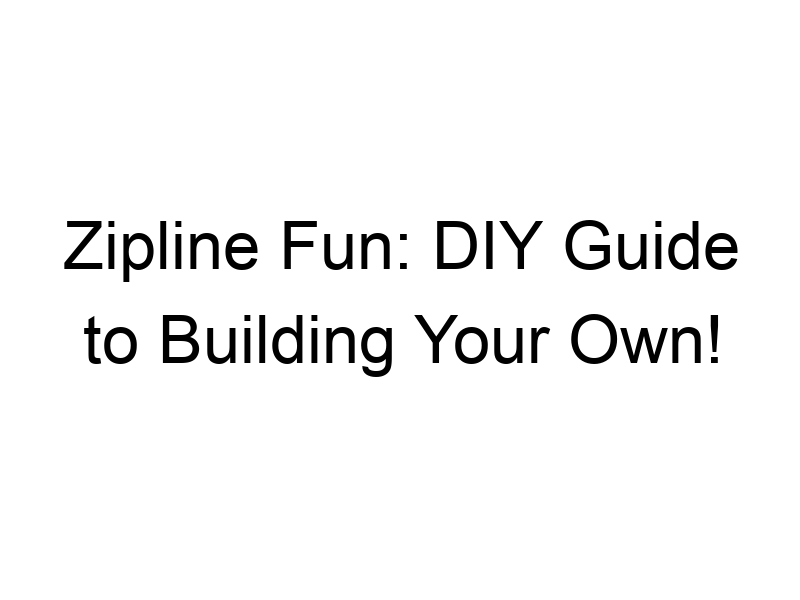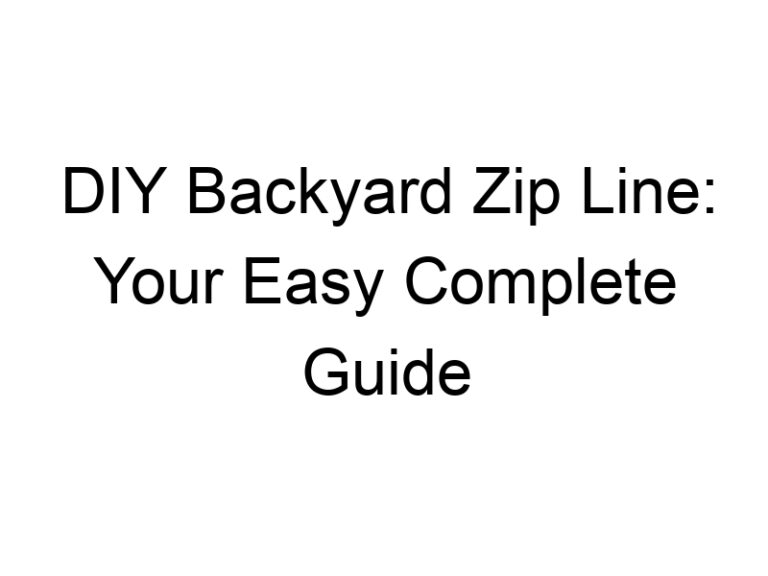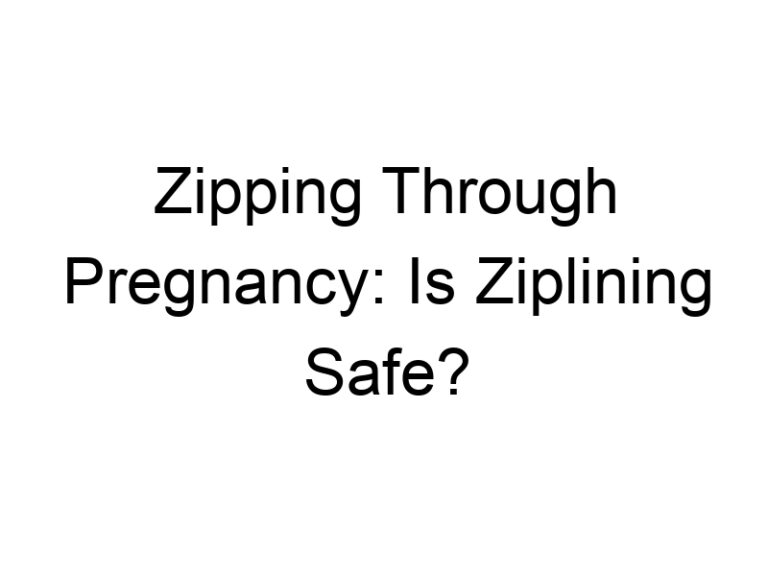Thinking about adding some excitement to your backyard? Why not try building your own zipline? It’s a fantastic way to have fun and get a bit of a thrill right at home. Plus, it’s a great project to take on if you enjoy DIY activities. This guide will walk you through the basics of constructing a zipline, from understanding the essential components to ensuring safety and choosing the perfect spot for your setup. Let’s get started on this adventure!
Key Takeaways
- Learn the essential parts needed to build a zipline.
- Understand the importance of safety when constructing a DIY zipline.
- Find out how to pick the best location for your zipline.
- Get tips on gathering materials and tools for the project.
- Discover how to maintain your zipline for long-lasting fun.
Understanding the Basics of Zipline Construction

Essential Components of a Zipline
Building a zipline isn’t rocket science, but you gotta know the parts. First off, you need a solid cable. This is what you’ll be zipping along, so make sure it’s strong enough to hold the weight. Next, there’s the trolley, which is the part that slides along the cable. Don’t skimp on this; a good one makes for a smoother ride. Then, you’ve got your anchor points. These are usually trees or sturdy posts that hold the cable up.
Safety Considerations for DIY Ziplines
Safety first, right? When setting up your zipline, think about the height and speed. Too high or too fast, and it could be dangerous. Use a harness and helmet, always. Also, check the equipment regularly. Look for signs of wear and tear, especially on the cable and trolley.
Choosing the Right Location for Your Zipline
Location is key. You want a place with a slight slope, maybe around 3% to 6%. This gives you a nice ride without going too fast. Avoid areas with obstacles like rocks or trees in the path. It’s also smart to pick a spot where you can easily set up your anchor points. If you’re looking to transform your yard, you might consider DIY outdoor stone steps to complement the zipline setup.
Gathering Materials and Tools for Your Zipline
List of Necessary Materials
Building your own zipline is a thrilling project, but to get started, you’ll need a few key materials. Here’s what you’ll need to gather:
- Steel Cable: The backbone of your zipline. Make sure it’s long enough to span your chosen area.
- Pulley: Essential for smooth rides. Choose one that can handle the weight and speed.
- Carabiners: These are crucial for connecting parts securely.
- Cable Clamps: Ensure the cable stays in place and doesn’t slip.
- Turnbuckles: These help in adjusting the tension of the cable, which is vital for safety.
- Protective Tubing: To avoid damaging trees or poles, wrap the cable ends.
Recommended Tools for Construction
Having the right tools makes the job much easier. Here’s a quick list of what you’ll need:
- Wrench: For tightening clamps and other fittings.
- Drill: Useful for making holes in wooden handles or platforms.
- Saw: Handy if you need to cut wood for platforms or handles.
- Measuring Tape: To ensure everything is aligned properly.
- Lighter: To seal the ends of ropes and prevent fraying.
Where to Source Your Zipline Supplies
Finding the right supplies can be a bit of a hunt, but here are some tips:
- Local Hardware Stores: They often have the basic materials like cables and clamps.
- Online Retailers: Websites can offer specialized zipline kits that include everything you need.
- Second-hand Markets: Sometimes you can find good deals on tools or materials.
Building a zipline doesn’t have to break the bank. With a bit of creativity and resourcefulness, you can find most of what you need without spending a fortune.
Designing Your Zipline: Key Considerations

Determining the Length and Slope
Before you even start buying materials, you need to figure out how long your zipline will be and the slope it will have. A good rule of thumb is to keep the slope between 3% to 6%. This means a 3 to 6-foot drop for every 100 feet of cable. If you go steeper than that, you could end up with a zipline that’s too fast and dangerous. Grab a tape measure and some chalk, and mark out where you want the start and end points to be.
Quick Tip: Use a natural slope in your yard if you have one—it’ll make things easier.
Selecting the Best Cable Type
Choosing the right cable is super important. You want something strong enough to hold the weight but not too heavy to handle. Most folks go for galvanized or stainless steel cables. They’re durable and can handle the elements. Make sure you check the weight rating on the cable package. You don’t want to skimp here—your safety depends on it.
Incorporating Safety Features
Safety is key when you’re setting up a zipline. Think about adding a braking system to slow things down at the end. You can also add a harness or seat to make the ride more comfortable and secure. Don’t forget to include some kind of safety gear like helmets and gloves. And, make sure your anchor points are solid—trees or posts that are at least 12 inches in diameter are usually a safe bet.
“Your zipline should be as safe as it is fun. Double-check everything before you let anyone take a ride.”
For more comprehensive guidance, especially if you’re involved in any research or trials, check out designing Diversity Plans for clinical trials to ensure you’re considering all aspects of safety and design.
Building a Zipline Platform: Step-by-Step Guide

Materials Needed for the Platform
Constructing a zipline platform might seem daunting, but with the right materials, you’re halfway there. Here’s what you’ll need:
- Wooden planks: For the platform base, sturdy and weather-resistant wood is crucial. Think about using treated lumber to withstand the elements.
- Metal brackets: Essential for securing the structure. These will hold your platform together and ensure stability.
- Screws and bolts: Make sure you have a variety of sizes to fasten everything securely.
- Ladder: Depending on your setup, you might need a ladder for access.
Constructing a Platform with or Without Trees
Building a platform can be done with or without natural supports like trees. Here’s how:
- Choose your site: Find a flat, stable area. If you have trees, they can serve as natural anchors. If not, you’ll need to build a freestanding structure.
- Measure and cut: Cut your wooden planks to the desired size for your platform. Make sure the base is large enough for safe use.
- Assemble the base: Use metal brackets and screws to attach the planks together. If you’re using trees, secure the platform to the trunks with additional support beams.
- Add supports: If you’re not using trees, build four sturdy legs to support the platform. Ensure they’re level and secure.
Ensuring Stability and Safety
Safety is paramount when building a zipline platform. Here’s how to keep it safe:
- Level the platform: Use a spirit level to check that your platform is even. Uneven surfaces can be dangerous.
- Secure all connections: Double-check that all screws, bolts, and brackets are tight. Loose connections can lead to instability.
- Test for stability: Before use, apply weight to the platform to ensure it holds firm. Adjust as necessary.
Building a zipline platform is not just about construction; it’s about creating a safe launchpad for fun. Take your time, follow the steps, and soon you’ll have a fantastic setup for endless adventures.
Installing the Zipline Cable: A Detailed Process
Securing the Cable to Anchor Points
Getting the cable set up is the first real step in making your zipline a reality. Properly securing the cable is super important for safety and functionality. Here’s how you can do it:
- Identify Anchor Points: Choose sturdy trees or posts. Make sure they’re strong enough to hold the tension of the cable and the weight of the riders.
- Wrap with Protection: Slide a plastic tube over the cable to protect both the cable and the tree. This helps avoid damage to the tree and keeps the cable from fraying.
- Create a Loop: Slide a cable clamp onto the cable, bend the cable back, and slide the end back into the clamp to form a loop. Tighten the clamp securely. This loop will hold one end of your turnbuckle.
- Attach the Turnbuckle: Connect the looped cable to one eye of the turnbuckle. Make sure the turnbuckle is fully extended to allow for future tension adjustments.
Adjusting Cable Tension
Getting the tension just right is key for a smooth ride. Too loose, and the zipline will sag; too tight, and it might snap or damage the anchor points.
- Initial Setup: With the turnbuckle fully extended, attach the other end of the cable to the opposite anchor point using the same looping method.
- Fine-Tuning: Gradually tighten the turnbuckle to increase tension. Aim for a slight sag when a test weight is applied. This sag should be about 2% of the total length of the zipline.
- Check and Double-Check: After adjusting, give the cable a good shake to ensure it’s secure and doesn’t move around.
Testing the Zipline for Safety
Before anyone gets on, you need to make sure everything’s working as it should be. Safety first!
- Visual Inspection: Check all clamps, loops, and connections. Everything should be tight and secure.
- Test Run: Use a weight equal to or greater than the heaviest expected rider. Let it slide down the cable to see how it performs.
- Adjust as Necessary: If the weight sags too much or doesn’t slide smoothly, revisit the tension settings.
Remember, a zipline is only as safe as its setup. Taking the time to double-check everything can prevent accidents and ensure a fun ride for everyone.
By following these steps, you’ll have your zipline cable installed safely and ready for action. Make sure to consider key factors like available anchors and safety considerations when choosing your site, as these can greatly affect installation success.
Creating a Safe and Fun Zipline Experience
Setting Up Safety Gear and Equipment
Before anyone takes a ride on your zipline, it’s important to set up the right safety gear. Safety should always be your top priority. Start with a reliable harness that fits snugly but comfortably. Helmets are non-negotiable, especially for kids. Make sure the trolley system is secure and check it regularly for any signs of wear. You might also want to add padding on trees or posts near the zipline to prevent injuries.
Establishing Zipline Rules and Guidelines
Clear rules can make a big difference in keeping everyone safe. First, decide who can use the zipline—kids, adults, or both? Set weight limits based on the equipment specifications. Only one person at a time should be on the zipline, and no one should stand in the landing area. Make sure everyone knows how to properly use the zipline, including how to hold the handles and how to dismount safely.
Supervising Children During Use
When kids are on the zipline, adult supervision is a must. Keep a close eye on them to ensure they’re following the rules and using the equipment correctly. It’s also a good idea to have an adult at both the start and end of the zipline to help with launching and landing. Encourage kids to speak up if they feel uncomfortable or scared at any point.
Remember, the goal is to have fun while staying safe. With the right precautions, your zipline can be a thrilling addition to your backyard adventures.
Troubleshooting Common Zipline Issues
Addressing Cable Sagging
Cable sagging is a common issue that can affect the performance of your zipline. Ensuring proper tension is crucial for a smooth ride. Here’s how you can address it:
- Check Cable Tension: Use a tensioning kit to ensure the cable is taut. The sag should be about 2% of the zipline’s total length.
- Inspect Anchor Points: Make sure anchor points are secure and not causing extra slack.
- Adjust Turnbuckles: If your setup includes turnbuckles, adjust them to tighten the cable.
Improving Zipline Speed
If your zipline feels sluggish, there are a few tweaks you can make to speed things up:
- Lubricate the Pulley: Apply a lubricant like WD40 to the pulley to reduce friction. This can significantly improve speed.
- Optimize Slope: Ensure the zipline slope is within the recommended range (3-6%). A steeper slope can increase speed.
- Reduce Cable Sag: As mentioned, a taut cable helps with speed. Recheck the tension to see if adjustments are needed.
Fixing Platform Instability
An unstable platform can be dangerous. Here’s how to stabilize it:
- Reinforce the Structure: Add extra supports or braces to the platform to enhance stability.
- Check Ground Anchors: Ensure that any ground anchors are deeply set and secure.
- Inspect for Damage: Regularly inspect the platform for any signs of wear or damage that could affect stability.
Safety is paramount when it comes to ziplining. Always perform a thorough check of all components before use to prevent accidents. Regular maintenance can save you from bigger issues down the line.
For more detailed information on handling personal data and privacy, you can contact us via Zipline’s privacy policy.
Enhancing Your Zipline with Accessories

Adding a Zipline Seat or Harness
A zipline seat or harness can transform your zipline experience, making it more comfortable and secure. Here’s how you can enhance your setup:
- Seats: Consider installing a sturdy seat for a relaxed ride. Look for options that are weather-resistant and easy to attach.
- Harnesses: For those seeking a more adventurous ride, a harness can provide added safety and freedom of movement.
- Installation: Most seats and harnesses come with simple installation instructions. Ensure they’re compatible with your zipline setup.
Choosing the right seat or harness can make all the difference in comfort and safety, especially for longer rides.
Incorporating a Braking System
Safety first! A braking system is essential to control speed and ensure safe stops. Here’s what to consider:
- Spring Brakes: These are affordable and easy to install. They work by compressing a spring to slow down the rider.
- Bungee Brakes: These offer a smoother stop by using elastic cords to decelerate gradually.
- Zippey Clip’n’Zip Trolley with Anti-Rollback Cam (ARC): This advanced system prevents rollback and ensures a safe stop every time.
Using Decorative Elements
Adding a personal touch to your zipline can enhance the fun. Consider these ideas:
- Colorful Flags: Attach flags along the line for a festive look.
- Thematic Elements: Incorporate themes like jungle or pirate adventures with props and decorations.
- Lighting: Use solar-powered lights for evening rides, adding both safety and ambiance.
Decorative elements not only beautify your zipline but also make it more engaging for everyone involved. Let your creativity shine!
Maintaining Your DIY Zipline for Longevity
Regular Inspection and Maintenance Tips
Keeping your zipline in top shape means regular check-ups. Start by inspecting the cable for any signs of wear or rust. Make sure the cable is taut and doesn’t sag more than necessary. For optimal performance, aim for a sag of at least 2% of the total length. For example, a 100-foot zip line should have a minimum sag of 2 feet. Check the anchor points for stability, and tighten any loose bolts or screws. Don’t forget to look at the trolley, ensuring wheels spin smoothly and there’s no debris stuck in them.
Replacing Worn-Out Parts
Over time, parts of your zipline might wear out. Regularly check the cable, trolley, and harness for any damage. If you find frayed cables or worn-out pulleys, replace them immediately to keep the zipline safe. It’s also a good idea to have spare parts on hand, like extra cable clamps and a backup trolley, just in case something breaks unexpectedly.
Seasonal Care and Storage
When the weather turns bad, it’s smart to take extra steps to protect your zipline. In winter or during heavy rain, consider taking down the trolley and storing it indoors to prevent rust. If possible, cover the cable with a tarp or remove it entirely to prolong its life. Remember, a little effort in caring for your zipline during off-seasons can save you a lot of hassle later on.
Keeping your zipline in good condition doesn’t just extend its life—it ensures every ride is as fun and safe as the first. Regular maintenance might seem like a chore, but it’s a small price to pay for peace of mind and endless outdoor fun.
Conclusion
Building your own backyard zipline isn’t just about the thrill of the ride; it’s about the journey of creating something fun and unique with your own hands. Sure, there might be a few hiccups along the way—like figuring out how to make that platform stable or getting the tension just right—but that’s all part of the adventure. Once it’s up and running, the smiles and laughter from your kids (or even the adults!) make it all worthwhile. So grab those tools, gather some materials, and get ready to transform your backyard into a mini adventure park. Who knows, you might even discover a hidden talent for DIY projects. Happy zipping!
Frequently Asked Questions
What materials do I need to build a zipline?
You’ll need a strong cable, two sturdy anchor points, a trolley, and safety gear like a harness and helmet.
How do I choose a good location for my zipline?
Pick a spot with enough space and a clear path between two stable points, like trees or poles.
What safety measures should I take?
Always wear a helmet and harness, check the cable tension, and supervise children while they’re using the zipline.
Can I build a zipline without trees?
Yes, you can use wooden or metal posts as anchor points if you don’t have trees.
How do I adjust the tension of the zipline cable?
Use a turnbuckle or a similar tool to tighten or loosen the cable until it has the right tension.
What should I do if the zipline sags?
Check the cable tension and tighten it. If it still sags, the cable might be too long or the anchors might need reinforcement.
How can I make my zipline ride faster?
Reduce friction by using a smooth trolley and ensuring the cable is properly tensioned.
How often should I inspect my zipline?
Regularly check for wear and tear, especially before each use, to ensure everything is safe and secure.



